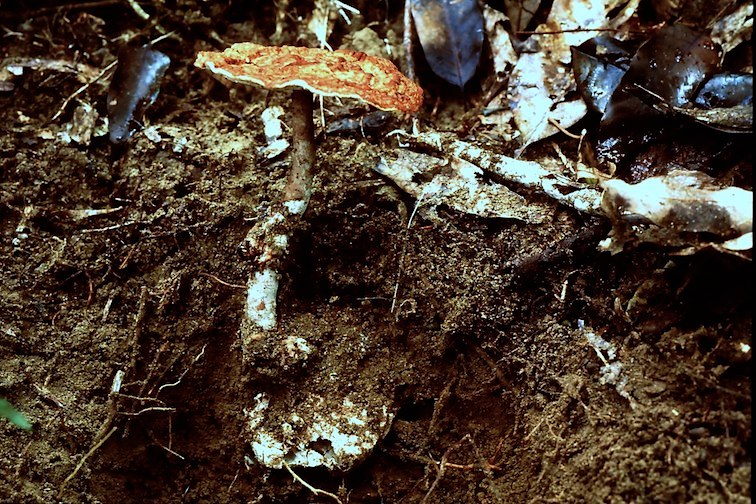- Proposed
- Under Assessment
- DDPreliminary Assessed
- 4Assessed
- 5Published
Lignosus rhinocerotis (Cooke) Ryvarden
- Scientific name
- Lignosus rhinocerotis
- Author
- (Cooke) Ryvarden
- Common names
 Hijiri-take
Hijiri-take Tiger milk mushroom
Tiger milk mushroom Cendawan susu rimau
Cendawan susu rimau 老虎奶
老虎奶 虎乳灵芝
虎乳灵芝 ヒジリタケ
ヒジリタケ- IUCN Specialist Group
 Mushroom, Bracket and Puffball
Mushroom, Bracket and Puffball- Kingdom
- Fungi
- Phylum
- Basidiomycota
- Class
- Agaricomycetes
- Order
- Polyporales
- Family
- Polyporaceae
- Assessment status
- Preliminary Assessed
- Preliminary Category
- DD
- Proposed by
- Tsutomu Hattori
- Assessors
- Tsutomu Hattori
- Comments etc.
- Anders Dahlberg
Assessment Notes
Taxonomic notes
Lignosus rhinocerotis has been considered as the only Asian species of this genus (Ryvarden and Johansen 1980), but it actually represents a species complex, and recently some additional species were described from tropical China and Malaysia (Cui et al. 2011; Tan et al. 2013). It is desirable to make detailed studies on distribution and ecology of each accepted species.
Why suggested for a Global Red List Assessment?
This species is widely distributed in tropical areas of Southeast Asia and Australasia, but rare in most localities. It is a terrestrial polypore usually grows on a sclerotium, and likely occurs on sandy ground along natural streams in lowland to middle hill forests of Southeast Asia. Many of the natural streams are destroyed by constructions of dams and artificial waterways in these areas. It is also widely known as a medicinal fungi in Malaysia and surrounding areas, and local people frequently collect this fungus. Sclerotia are also collected, so whole mycelia are removed in case of collection.
For the time being, it is most possibly a DD species, but an important target to monitor in the Southeast Asia.
Geographic range
Lignosus rhinocerotis s.l. has been recorded from various tropical and subtropical areas of Southeast Asia and Australasia including Malaysia, Indonesia, Thailand, the Philippines, China, Japan, Sri Lanka, and Australia.
Population and Trends
As it is distributed mainly in deep tropical rain forests, few detailed information about population trends is available from most countries, but rare in many countries. In Malaysia, local people collect this fungus intensively, which may induce decline of this fungus. Many of the fruiting bodies sold in the markets are immature, and whole mycelia including the sclerotia are likely pillaged before their maturity.
Lowland rain forests have been seriously declined most of its distribution countries.
Population Trend: Uncertain
Habitat and Ecology
This is a wood rotting fungi causing a white rot. It sometimes fruit on decayed trees, but usually occur on buried sclerotia, possibly accosted with buried woody materials or wood nearby the sclerotia. In Japan, it has been collected on sandy ground near natural streams and river plain.
Threats
Deforestation of lowland rain forest, dam construction and artificial river wall are primary threats for this fungus. Over harvest can be a threat for this fungus in Malaysia and surrounding countries. Sclerotia as well as fruiting bodies are collected in young condition before sporulation, which may induce serious population reduction.
Conservation Actions
Conservation of natural streams and surrounding forests is the primary action. It is also desirable to control over harvest and destruction of the habitat during harvest. Circulation of the cultivated fungus might reduce the amount of harvesting of natural fruiting bodies and sclerotia.
Research needed
Taxonomical studies are desirable to differentiate habitat, ecology and distribution of this fungus and its allies. Distribution of the recently described species are still not well investigated. Changes of distribution amount in markets by year and locality may help to know fluctuation and detailed distribution of this fungus.
Use and Trade
Bibliography
Annonynous 2014. Threatened wildlife of Japan. Red data book 2014 bryophytes, algae, lichens, fungi. Gyousei, Tokyo.
Corner E.J.H. 1989. Ad Polyporaceas VI. Beih. Nova Hedwig.97:1–197.
Cui, B.K.; Tang, L.P.; Dai, Y.C. 2011. Morphological and molecular evidences for a new species of Lignosus (Polyporales, Basidiomycota) from tropical China. Mycological Progress 10:267–271.
Cunningham, G.H. Polyporaceae of New Zealand. New Zealand Dept. Sci. Indust. Res. 14:1–304.
Dai, Y.C. 2012. Polypore diversity in China with an annotated checklist of Chinese polypores. Mycoscience 53:49–80
Hattori, T; Rashid, N.M.N.; Ujang, S. 2007. Basidiomycota: diversity of Malaysian polypores. Malaysian Fungal Diversity, pp. 55–68.
Hattori, T; Yamashita, S; Lee, S.S. 2012. Diversity and conservation of wood-inhabiting polypores and other aphyllophoraceous fungi in Malaysia. Biodiversity and Conservation 21:2375–2396.
Quanten, E. 1997. The polypores (Polyporaceae s.l.) of Papua New Guinea. Opera Botanica Belgica 11:1–352
Ryvarden, L; Johansen, I. 1980. Preliminary polypore flora of East Africa. Fungiflora.
Tan, C.S.; Ng, S.T.; Tan, J. 2013. Two new species of Lignosus (Polyporaceae) from Malaysia– L. tigris and L. cameronensis. Mycotaxon 123:193–204
Country occurrence
Regional Population and Trends
| Country | Trend | Redlisted |
|---|
